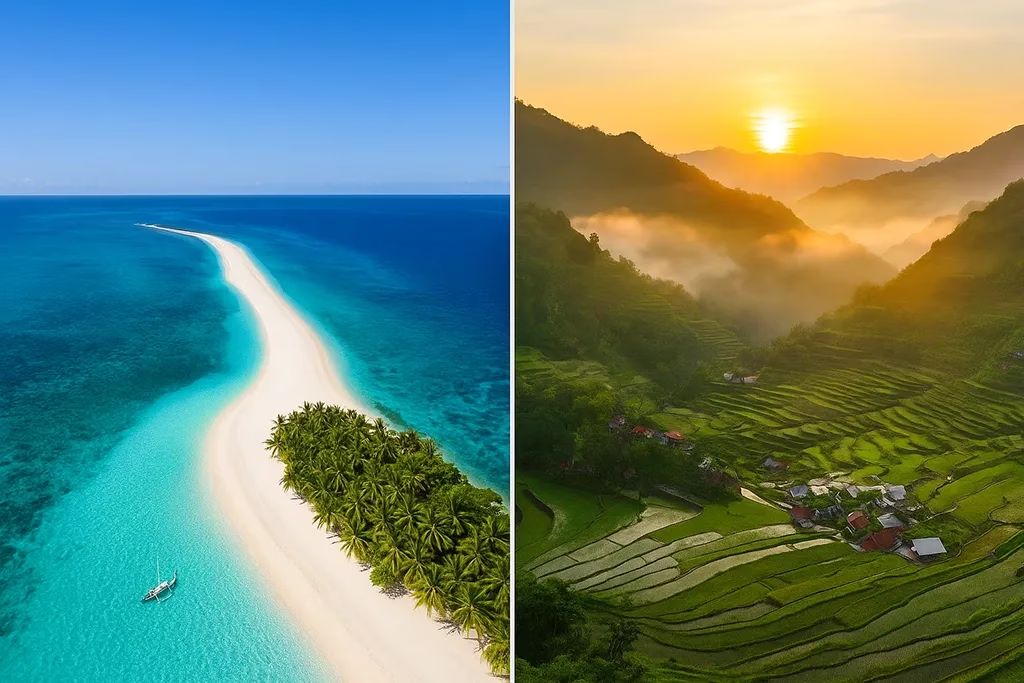
Picture this: Boracay at sunset. Gorgeous, yes—but also full of sunburnt tourists taking selfies with the same mango shake you ordered 20 minutes ago. Meanwhile, somewhere in the Philippines, there’s an island where the only crowd is a group of goats, the beer is cheaper than bottled water, and your hammock view is better than any influencer’s drone shot. Welcome to the Hidden Islands of the Philippines—the offbeat, the overlooked, the oh-my-God-why-didn’t-I-come-here-sooner destinations.
This is where Millennials (yes, you with your camera roll of avocado toast) go when they’re done with overhyped beaches and want something wilder, cheaper, and infinitely tastier.
Why Skip the Usual? (Hint: Crowds, Prices, and Regret Hangovers)
Sure, Boracay and Palawan are stunning. They’re also the reason your cocktail costs as much as your hotel room. Hidden gems, on the other hand, give you:
- Beaches with zero sunbed fees.
- Meals that taste like grandma’s love letter and cost less than a latte back home.
- Bragging rights. Because nothing says “seasoned traveler” like casually dropping, “Oh, I was just in Camiguin for the Lanzones Festival.”
Adventure travelers don’t follow the crowds; they follow the stories. And trust me, the Philippines has thousands of them.
Hidden places also give you more authentic interactions with locals. Instead of waiters trained to recite cocktail menus in five languages, you’ll meet grandmothers who insist you try their homemade rice cakes and won’t take no for an answer. The Philippines is about people as much as it is about places, and hidden corners of the country remind you of that in the warmest—and tastiest—ways.
Luzon’s Secret Stash – Where Mountains Meet Myths (and Meat Stews)
Bontoc & Sagada – The Hanging Coffins and Cloud-Chasing Life
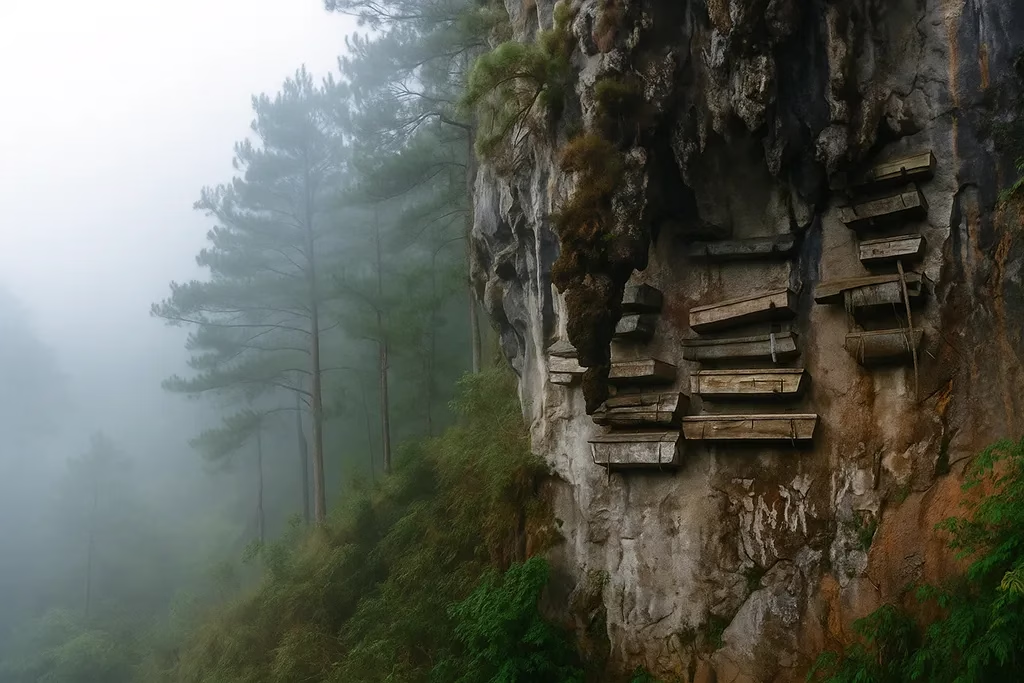
Want adventure with a side of “Wait, they buried people where?” Head to Sagada for its hanging coffins. Add spelunking in Sumaguing Cave, and you’ll feel like Indiana Jones, but with a lot more sweat. Don’t skip sunrise at Kiltepan Viewpoint, where seas of clouds roll in like nature’s foam party.
While you’re here, wander through Echo Valley, a forested trail leading to sacred cliffs, and listen as your voice bounces back at you like nature’s karaoke machine. Visit the Lumiang Burial Cave, where centuries-old coffins are stacked like a morbid Jenga set. Or, for something more relaxing, try weaving workshops with locals who will gladly explain why patience is the most essential tool on a loom.
Foodie Fuel: Sagada coffee is legendary—dark, bold, and strong enough to power Wi-Fi in the mountains. Pair it with pinikpikan, a chicken stew that’s both hearty and steeped in tradition. If you’re a dessert hunter, blueberry yogurt from local farms is the post-hike hug you never knew you needed.
Ifugao’s Rice Terraces – Beauty Beyond Banaue Postcards
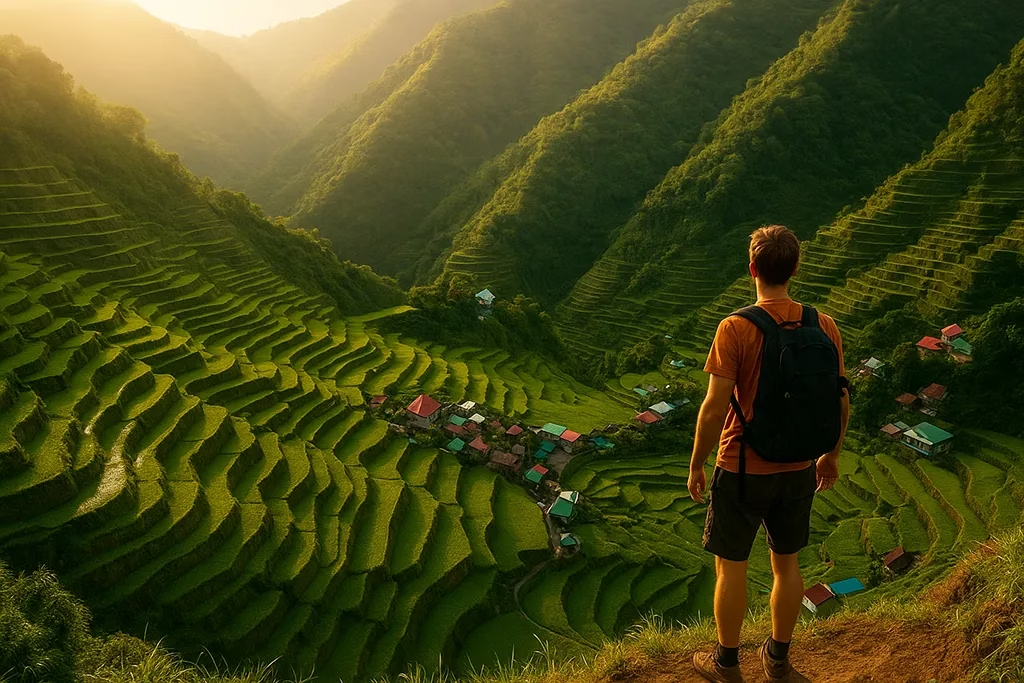
The Banaue Rice Terraces get the fame, but Batad’s amphitheater-shaped terraces are real showstoppers. Trekking here offers a cardio workout with cultural rewards. Stay in a village homestay and let the Ifugao teach you that rice farming is equal parts art, survival, and spiritual practice.
Spend time at the Ifugao Museum or join locals during harvest festivals to see the terraces come alive with chants, rituals, and more rice than you thought could exist in one place. The hike to Tappiya Falls is also a must—a mighty cascade that makes every aching calf muscle worth it.
Foodie Fuel: Sip tapuy rice wine while eating tinawon heirloom rice. If carbs and booze had a baby, this would be it. Bonus: If you’re lucky, you’ll be invited to a feast where rice takes center stage in more forms than you thought possible—cakes, porridges, spirits, and snacks.
Bicol’s Fiery Playground – Volcano Thrills Without the Throngs

Mayon Volcano is so symmetrical that it looks Photoshopped. ATV around its lava trails or head to Donsol for whale shark encounters. Bicol also brims with waterfalls and secret coves that few tourists ever bother to find.
Climb up to Cagsawa Ruins and frame your Mayon photo with a haunting bell tower left behind after the 1814 eruption. If you’ve got stamina, hike Mount Isarog or dive into waterfalls like Malabsay. You’ll discover that Bicol is as much about adrenaline as it is about breathtaking landscapes.
Foodie Fuel: Bicol Express—pork in coconut milk and chilies—is the edible equivalent of a dare. Don’t forget laing (taro leaves stewed in coconut milk). It’s the kind of dish that makes you reconsider your relationship with vegetables.
Visayas Unplugged – Islands Without the Hype (But with Heavenly Snacks)
Siquijor – The Island of Magic (and Mystical Meals)

Known for its healers and waterfalls, Siquijor whispers mystery and delivers cliff-jumping thrills at Cambugahay Falls. Some come for witchcraft tales, others for the beaches that feel like secrets you shouldn’t be allowed to keep.
Don’t miss Salagdoong Beach for cliff-diving daredevils or Lugnason Falls for a quieter swim. By night, the island glows with fireflies in mangrove forests—Mother Nature’s version of fairy lights. And if you’re curious about traditional healing, local herbalists still offer remedies passed down for generations.
Foodie Fuel: Snack on torta pastries or peanut brittle. Pair that with tuba (fermented coconut wine) if you dare. This island makes even dessert feel a little enchanted.
Camiguin – Tiny Island, Big Volcano Energy
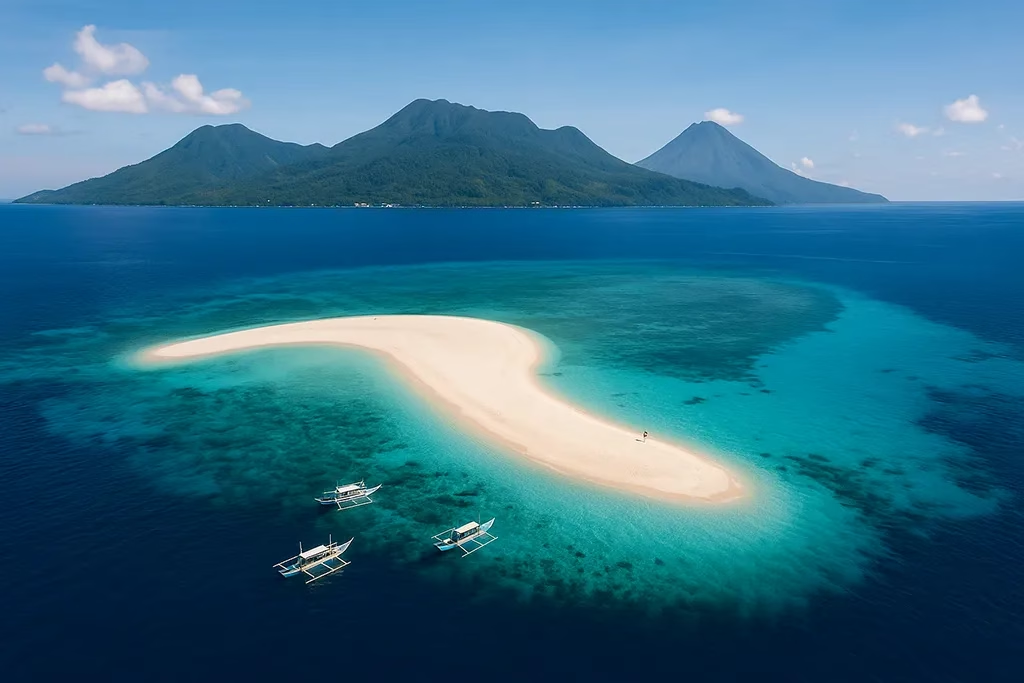
Camiguin may be small, but it packs hot springs, waterfalls, and a Sunken Cemetery. It’s basically nature showing off. Hike Mount Hibok-Hibok if your legs are feeling brave, then soak in Ardent Hot Springs to remember why relaxation exists.
Spend an afternoon exploring White Island Sandbar—just you, powdery sand, and endless views of volcanoes. Trek to Katibawasan Falls, a curtain of water cascading into a cold plunge pool that will jolt your senses awake. Camiguin is proof that good things really do come in small, volcanic packages.
Foodie Fuel: The island’s prized lanzones fruit is so sweet there’s a whole festival in its honor. Lanzones are like candy from trees, proof that fruit doesn’t have to be boring. Try pastel too—a soft bun filled with yema (custard). One bite, and you’ll wonder if you need a separate suitcase for snacks.
Leyte – Where History and Beaches Swipe Right

Kalanggaman Island is Beyoncé in sandbar form. Add WWII history at the MacArthur Landing Memorial, and you’ve got the most random but perfect mix of beach and history class. Visit Lake Danao, shaped like a guitar, for kayaking that doubles as a geography lesson.
Head over to Cuatro Islas for island-hopping bliss. Each island offers different flavors of paradise—white sand, snorkeling, and that blissful “I could live here forever” vibe. History buffs will also love the Battle of Leyte Gulf markers scattered around the island, turning every stroll into a history lesson.
Foodie Fuel: Binagol (taro, coconut, and sugar steamed in a shell) and moron (chocolate sticky rice rolls). Delicious, despite the name suggesting otherwise. End with delicacies like sagmani (root crops in coconut milk) and you’ll leave Leyte with a food baby worth the trip.
Dumaguete – City of Gentle People with Wild Adventures Next Door
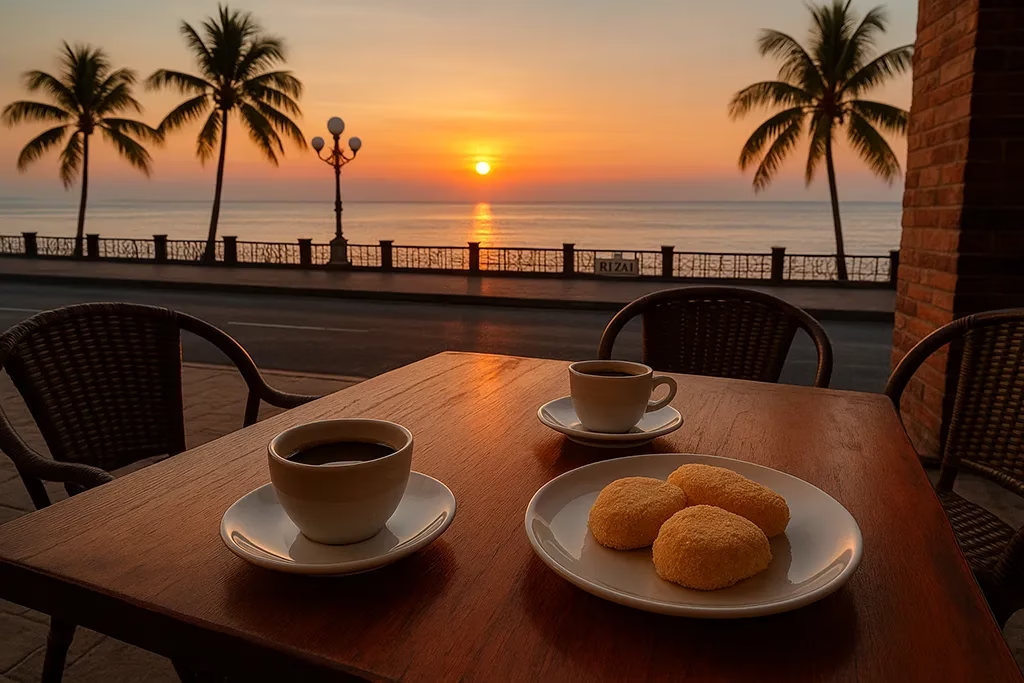
The vibe is chill: sunsets at Rizal Boulevard, coffee shops galore, and turtle dives at nearby Apo Island. It’s a college town where expats, artists, and students mix, and where life feels slower without being sleepy.
Visit Silliman University, the first American university in Asia, and explore its leafy campus and anthropology museum. Hop over to Twin Lakes Balinsasayao and Danao for kayaking rides framed by forested mountains. Dumaguete is the kind of place where you plan to stay three days and end up staying three months.
Foodie Fuel: Silvanas—frozen, buttery cookie sandwiches—and budbud kabog, a sticky rice treat wrapped in banana leaves. Both are worth smuggling in your backpack. Pair them with tsokolate (Filipino hot chocolate) and you’ll forgive yourself for skipping your dive.
Offbeat Adventures to Brag About Later (and Snack On)

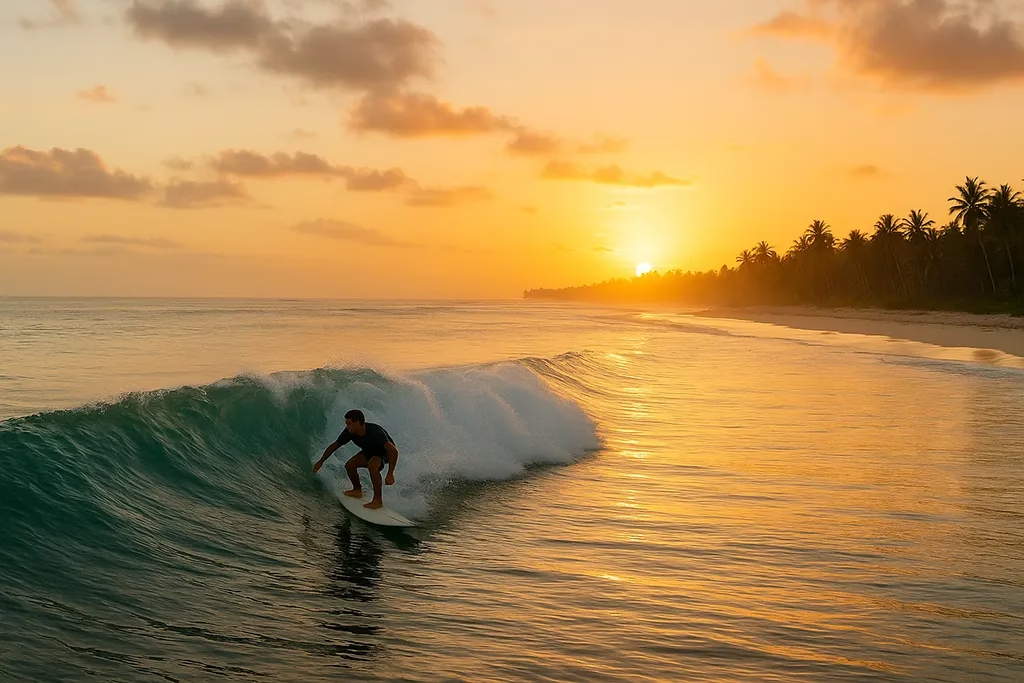
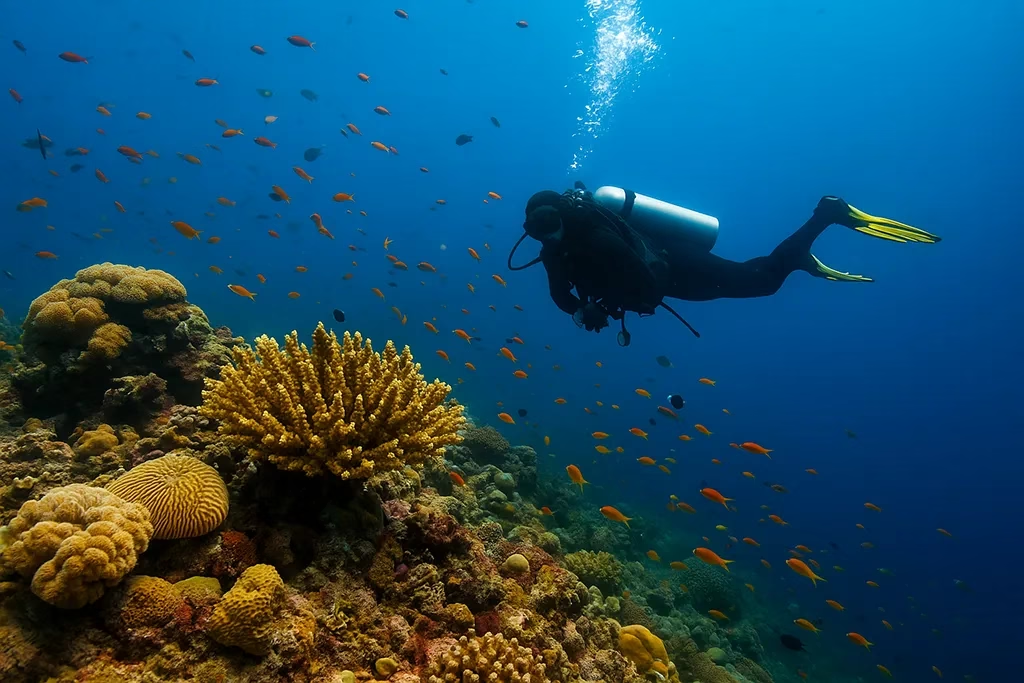

2. Surf’s up minus the crowd—Guiuan’s secret waves roll just for you.
3. Beneath the waves of Mindoro, color riots quietly on the world’s third-largest reef.
4. Cloud nine is real—and it’s called Mount Pulag at sunrise.
- Samar Caves: Giant caverns where you’ll feel like a mosquito. Refuel with tamalos, oversized rice tamales stuffed like they’re going out of style. The Calbiga Caves are among Asia’s largest, where chambers stretch like underground cathedrals. Bring a headlamp and a sense of humor—you’ll need both.
- Guiuan, Eastern Samar: Surf spots that offer a break from the Siargao hype. Reward yourself with ridiculously fresh seafood grilled straight from the boat. Explore historic churches and deserted beaches that feel like they were placed on Earth just for you.
- Mount Pulag: Sunrise above the clouds. Pack mountain vegetables sautéed carinderia-style—because hiking tastes better with garlic and soy sauce. The trek takes you through mossy forests, dwarf bamboo fields, and eventually to a summit where you’ll stand above the clouds like a victorious mountain goat.
- Northern Mindoro: Trek to Tamaraw Falls, then munch on fresh buko pie. Visit Apo Reef, one of the world’s largest coral reef systems, for diving that rivals the Great Barrier Reef—minus the tourist buses. Mindoro is for those who love the thrill of discovery without having to share it with thousands of others.
Culture Hidden in Plain Sight (and on Your Plate)
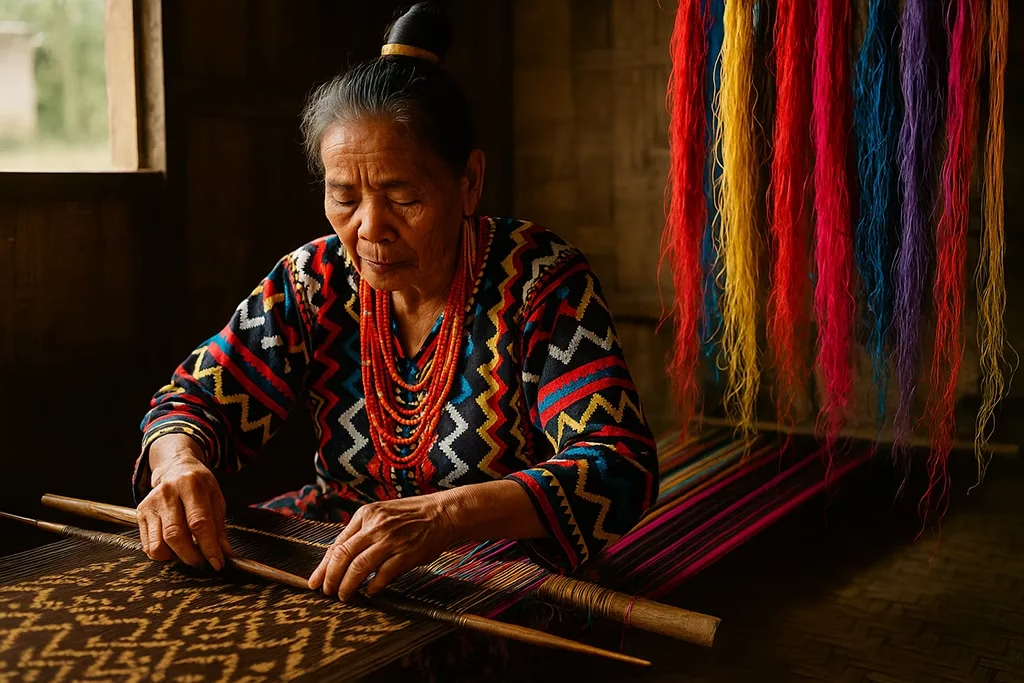
Hidden gems preserve culture more effectively than any museum gift shop. Watch T’boli dream weavers create T’nalak cloth, hear kulintang gongs in Mindanao, or stumble into a fiesta where you’ll be force-fed until you admit defeat.

Foodie Fuel: Festivals mean street food heaven. Cebu’s lechon (roast pig) is so good you’ll wonder if it’s the real reason Magellan stopped by. In Leyte, the Pintados Festival mixes tribal body painting with dishes that require stretchy pants. Camiguin’s Lanzones Festival brings about the fruit parades and sugar highs.
Travel Tips for Going Where No One’s Looking
- Transport: Planes, ferries, trikes, and occasionally a motorbike that sounds like it’s narrating your doom.
- Budget: Meals from $1, resorts from $20. Diving tours $30–50. Hidden gems = cheaper stays, pricier trike rides.
- Health: Bring travel insurance and mosquito spray—dengue isn’t the souvenir you want.
- Respect: Don’t turn sacred sites into selfie props. Eat what’s offered. Say thank you. Mean it.
For a smoother travel experience, consider learning a few Tagalog or Bisaya phrases. A simple “salamat” (thank you) gets you smiles. A “busog na ako” (I’m full) might save you from your fourth round of merienda.
Wrap-Up – The Hidden Philippines Is Waiting (With Snacks)
The Philippines isn’t just about the beaches you see in travel ads. It’s about misty mountains, eerie cemeteries, magical festivals, and food that convinces you to stay longer than planned. Skip the crowded spots. Go where no one’s looking. And when you do, eat everything.
Adventure isn’t just cliffs and caves—it’s the taste of silvanas, the heat of Bicol Express, and the joy of discovering a place that hasn’t been Instagrammed to death.
Pack your curiosity, your appetite, and maybe some stretchy pants. The Hidden Philippines is calling—and it’s bringing dessert.
🙋 FAQ Section
1. What are the best hidden gems in the Philippines?
Skip the usual Boracay and Palawan—check out Sagada’s hanging coffins, Camiguin’s hot springs, Leyte’s Kalanggaman sandbar, and Siquijor’s waterfalls.
2. Is it safe to travel to hidden destinations in the Philippines?
Yes—most are safe and welcoming, especially if you respect local customs. Just bring mosquito spray, common sense, and a smile.
3. How do I get to off-the-beaten-path places in the Philippines?
Think ferries, tricycles, jeepneys, and the occasional habal-habal (motorbike taxi). Half the fun is the journey—unless you hate transfers.
4. What kind of food should I try in these hidden spots?
Expect everything from spicy Bicol Express to Camiguin’s lanzones fruit, Dumaguete’s silvanas, and Sagada’s strong coffee. Basically: stretchy pants required.
5. Are hidden destinations in the Philippines budget-friendly?
Yes! Meals often cost $1–3, lodging can be under $20 a night, and island-hopping tours are far cheaper than mainstream tourist hubs.
6. When is the best time to explore the hidden Philippines?
Dry season (Dec–May) is perfect for beach-hopping. Rainy season (Jun–Nov) brings lush waterfalls, fewer tourists, and more excuses for second helpings of dessert.
Other Articles that may be of Interest
You may also find the following articles interesting.
- Don’t Tell Anyone: The Philippines’ 10 Best Hidden Gems
- Iloilo Itinerary for Seniors Who Love Culture and Cameras
Suggestions For Lodging and Travel
Lodging is widely available throughout the Philippines. However, you may want to consider getting assistance booking tours to some of the Philippines’ attractions. I’ve provided a few local agencies that we’ve found to be very good for setting up tours. For transparency, we may earn a commission when you click on certain links in this article, but this doesn’t influence our editorial standards. We only recommend services that we genuinely believe will enhance your travel experiences. This will not cost you anything, and I can continue to support this site through these links.
Local Lodging Assistance
- Guide to the Philippines: This site specializes in tours throughout the Philippines, offering flexibility in scheduling and competitive pricing. I highly recommend them for booking local arrangements for a trip like this one. You can book flights and hotels through the Expedia link provided below.
- Hotel Accommodations: I highly recommend The Manila Hotel for a stay in Manila. I stay here every time I travel to the Philippines. It is centrally located, and many attractions are easily accessible from there. Intramuros and Rizal Park are within walking distance. I have provided a search box below for you to use to search for hotels (click on “Stays” at the top) or flights (click on “Flights” at the top). This tool will provide me with an affiliate commission (at no additional cost to you).
- Kapwa Travel is a travel company focused on the Philippines. It specializes in customizing trips to meet customers’ needs.
- Tourismo Filipino is a well-established company that has been operating for over 40 years. It specializes in tailoring tours to meet customers’ needs.
- Tropical Experience Travel Services – Tours of the Philippines: This company offers a range of tour packages, allowing you to tailor your trip to your preferences.
Lastly, we recommend booking international travel flights through established organizations rather than a local travel agent in the Philippines. I recommend Expedia.com (see the box below), the site I use to book my international travel. I have provided a search box below for you to use to search for flights (click on “Flights” at the top) or Hotels (click on “Stays” at the top). This tool will provide me with an affiliate commission (at no cost to you).